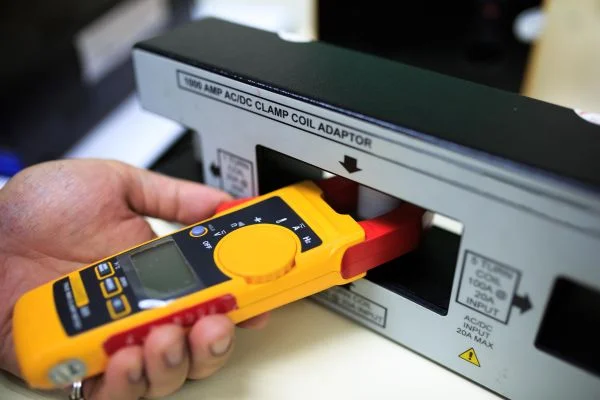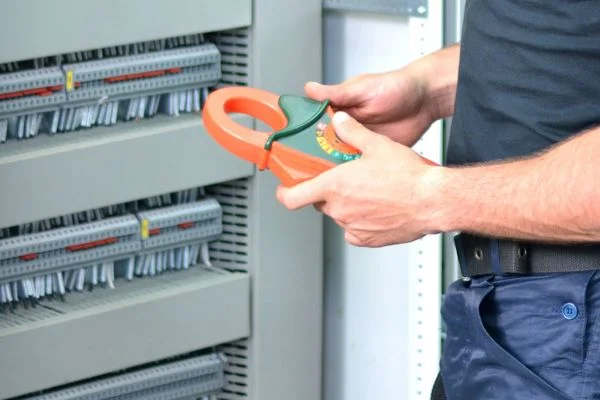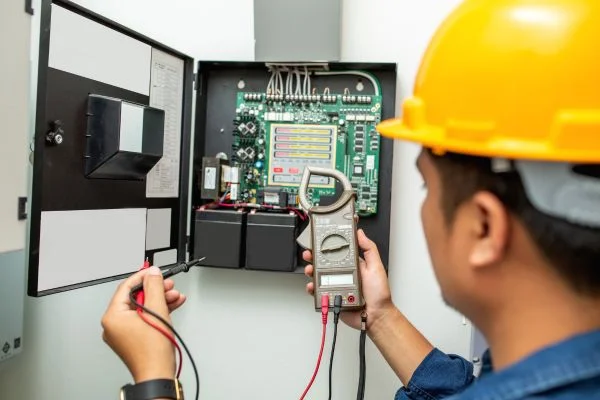Voltage measurement is a crucial part of electrical work, ensuring the safety and efficiency of electrical systems. Having the right tools at your disposal is essential for electricians, and one such tool is the clamp meter.
It allows you to measure voltage accurately without being in direct contact with live wires, making it safer and more convenient. But before knowing how to use clamp meter to measure voltage, you need to know about voltage and clamp meter working.
Quick Guide
“To use a clamp meter for voltage measurement, turn the meter on and select the voltage setting. Open the clamp and place it around an insulated wire. It is important to ensure that the wire sits properly within the jaws. After positioning the Clamp meter, read the display.”
What is Voltage?
The voltage is measured in volts (V), also known as the electric potential difference. In a circuit, it’s the “push” that moves electrons. Think of it as the source of power that powers everything you use electrically, from your smartphone charger to the lights in your house. In the absence of voltage, electricity would not flow, and nothing would work.
How does a clamp meter work and what are its uses?
With a clamp meter, you can measure electrical current without disconnecting wires. It resembles a pair of pliers with a digital display. It measures the flow of current through a wire by clamping its jaws around it.

A clamp meter can be extremely useful in a variety of situations. Many electricians use them to troubleshoot electrical problems, such as overloading circuits or overdrawing devices. Clamp meters can be used by homeowners to monitor the power consumption of their appliances or to make sure their circuits are safe.
They are also useful for HVAC technicians when diagnosing heating and cooling problems. Electrical measurements are safer, faster, and more convenient with clamp meters.
Read more about Best Budget Clamp Meter
How to use clamp meter to measure voltage| Step By Step
Having prepared your clamp meter and gained a basic understanding of voltage, it’s time to begin measuring voltage with this versatile tool. I’ll cover everything from choosing the right voltage range to interpreting the displayed values here.
Step#1 Choosing the Appropriate Voltage Range
Choose the clamp meter voltage range closest to the expected voltage of the circuit you are testing before measuring voltage. As a result, the meter will provide accurate readings.
Whenever you are unsure of the voltage level, start with a higher range and work your way down until you have a precise measurement.
Read more about Best Clamp Multimeter for Electricians
Step#2 Positioning the Clamp Meter Correctly

Voltage can be measured without making direct contact with wires. Place the clamp meter around a single wire or cable instead. Test wires must be centered within the clamp jaw in order to ensure a secure, accurate connection. It is crucial to follow the manufacturer’s instructions when positioning the clamp meter.
Step#3 Reading and Recording the Voltage
To obtain the voltage reading, press the measurement button or trigger once the clamp meter is properly positioned. Voltage will be displayed on the meter’s digital display.

Record this value for future reference. For convenience when working in tight spaces, some clamp meters have a hold function, which allows you to freeze the reading.
Step#4 Interpreting the Displayed Values
A clamp meter displays voltage measurements in volts (V). Check that the value falls within the expected range for the circuit. Recheck your clamp meter’s positioning and range settings if the reading is significantly higher or lower than expected.

To avoid misdiagnosing electrical problems, always double-check your measurements. You should take tips for accurate measurements after reading how to use clamp meter to measure voltage
Practical Tips for Accurate Measurements
In order to troubleshoot and maintain electrical systems, it is essential to measure voltage accurately. The following tips will help you measure voltage accurately and reliably with your clamp meter.
Tip#1 Avoiding Common Mistakes

Common mistakes include not making sure the clamp meter fits snugly and securely around the wire. Inaccurate readings can be caused by a loose connection. Measurements should always be taken with the clamp properly positioned and closed.
Tip#2 Maintaining a Stable Position

During measurement, hold the clamp meter steady to obtain accurate readings. The meter shouldn’t be moved or jiggled excessively, as this can result in fluctuations. Consistent and reliable measurements require a stable position.
Tip#4 Troubleshooting Issues with Voltage Measurement
You shouldn’t panic if your voltage readings are unexpected or inconsistent. Check the clamp meter’s position and range settings first. Ensure that the wire being measured is clean and free of obstructions.
If the issue persists, consider a faulty meter or an underlying electrical issue. In order to identify and resolve measurement issues effectively, troubleshooting should be conducted systematically.
Understanding the Clamp meter Display

Your clamp meter’s digital display provides crucial information about voltage measurements. For accurate assessments and troubleshooting, it is essential to understand how the display is interpreted. Let’s discuss how to read and understand the information presented.
Interpreting the Digital Display
There is a numeric value on the display that represents the voltage measurement in volts (V). You should verify that the voltage of the unit is consistent with what you expect (AC or DC).
Symbols or indicators may accompany the numerical value, such as a “V” for voltage or an “AC” or “DC” signifying the type of voltage.
Using Additional Functions and Settings
There are many clamp meters that offer additional functions and settings accessible through buttons or menus. They may include features such as hold, peak hold, or min/max recording.
You will find these functions useful when measuring voltage fluctuation or peak values, so familiarize yourself with them. To learn how to activate and use these features, consult your meter’s user manual.
Capturing and Recording Measurements
Clamp meters may come with built-in memory or data logging capabilities that allow you to record measurements for documentation or further analysis. There are also models that offer Bluetooth connectivity for transferring data to a smartphone or computer.
It can streamline your workflow and improve the accuracy of your records if you know how to capture and record measurements digitally, especially when working with complex electrical systems or troubleshooting problems.
Real-Life Applications
When it comes to practical applications in the field, understanding how to use clamp meter to measure voltage is important. A clamp meter can be used in a wide range of applications, including residential electrical work, industrial work, and commercial work.
Using a Clamp Meter in Residential Electrical Work
The clamp meter can be used in residential settings to diagnose electrical problems such as circuit overloads, faulty outlets, and voltage variations.
Clamp meters provide a quick and safe way to assess voltage without disrupting the electrical system, whether you’re installing new appliances or troubleshooting lighting problems.
Industrial and Commercial Applications
In industrial and commercial settings, clamp meters play a vital role in maintenance and safety. In addition to measuring current in heavy machinery and identifying overloaded circuits, they can also ensure electrical systems are operating within acceptable parameters. To prevent costly downtime, industrial electricians use clamp meters.
Troubleshooting Electrical Issues with a Clamp Meter
Troubleshooting electrical problems is one of the most common uses of a clamp meter. With a clamp meter, you can measure voltage and current to pinpoint the cause of a sudden power outage, overheating motor, or erratic circuit. Critical systems can be maintained smoothly with this diagnostic capability, minimizing downtime.
Final Words
It is essential to measure voltage accurately in the world of electrical work in order to ensure safety and efficiency. Electricians and DIY enthusiasts can perform this crucial task with confidence using a clamp meter, thanks to its convenience and versatility.
When you’re working on residential projects, performing industrial maintenance, or troubleshooting electrical issues, your clamp meter will ensure that your electrical systems operate smoothly and safely. Let your electrical work shine with precision and reliability by learning how to use clamp meter to measure voltage
Related Posts
